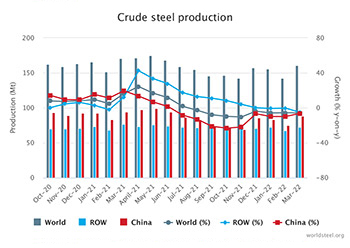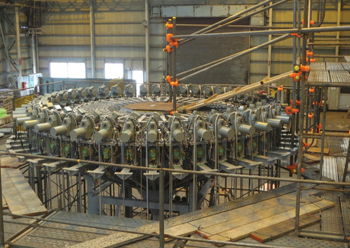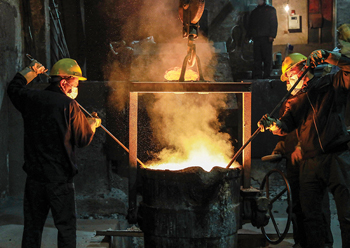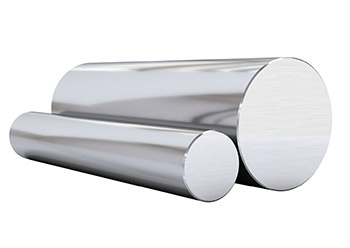
 Steel demand: the war in Ukraine creates a high degree of uncertainty
Steel demand: the war in Ukraine creates a high degree of uncertainty
Even as the global steel demand is set to grow marginally this year, forecasts for steel trade in 2023 is seen positively better – although the war in Ukraine creates a high degree of uncertainty.
Industry body the World Steel Association’s (worldsteel) Short Range Outlook (SRO) for 2022 and 2023, forecasts that steel demand will grow by 0.4 per cent this year to reach 1.84 million tonnes, after having increased by 2.7 per cent in 2021.
However, in 2023, steel demand is predicted to see a growth of 2.2 per cent to reach 1.88-million tonnes.
 |
|
|
The current forecast, however, has been made against the backdrop of the conflict in Ukraine and is subject to high uncertainty, while inflation can also cloud the outlook for steel demand.
Commenting on the outlook, Máximo Vedoya, chairman of the worldsteel Economics Committee, noted that the SRO had been made “in the shadow of the human and economic tragedy following the Russian invasion of Ukraine.”
In 2021, recovery from the pandemic shock turned out to be stronger than expected in many regions, despite continuing supply chain issues and Covid-19 waves. However, a sharper than anticipated deceleration in China led to lower global steel demand growth in 2021.
“For 2022 and 2023, the outlook is highly uncertain. The expectation of a continued and stable recovery from the pandemic has been shaken by the war in Ukraine and rising inflation,” Vedoya reiterated.
Magnitude of Impact
Worldsteel has said the magnitude of the impact of this conflict will vary across regions, depending on their direct trade and financial exposure to Russia and Ukraine.
There is an immediate devastating effect on Ukraine, consequences for Russia, and a major impact on the European Union (EU) owing to its reliance on Russian energy and its geographic proximity to the conflict area.
The impact will also be felt globally through higher energy and commodity prices – especially raw materials for steel production – and continued supply chain disruptions, which were troubling the global steel industry even before the war. Further, financial market volatility and heightened uncertainty will undermine investment.
Vedoya stated global spillovers from the war in Ukraine, along with low growth in China, point to reduced growth expectations for global steel demand in 2022.
There are further downside risks from the continued surge in virus infections in some parts of the world, especially China, and rising interest rates. The expected tightening of US monetary policies will hurt financially vulnerable emerging economies.
The outlook for 2023 is highly uncertain, according to Worldsteel, which assumes in its forecast that the confrontation in Ukraine will come to an end in the course of 2022 but that the sanctions on Russia will largely remain.
Additionally, the geopolitical situation surrounding Ukraine poses significant long-term implications for the global steel industry. Among them are a possible readjustment in global trade flows, a shift in energy trade and its impact on energy transitions, and continued reconfiguration of global supply chains.
Slowdown in China
The association reports that Chinese steel demand saw a major slowdown in 2021 owing to the tough government measures on real estate developers.
Steel demand will remain flat this year, as the government tries to boost infrastructure investment and stabilise the real estate market, it predicts. The stimuli introduced this year are likely to support small positive growth in steel demand in 2023.
There is upside potential from more substantial stimulus measures, which is likely if the economy faces more challenges from the deteriorating external environment.
Other Regions
In other advanced countries, despite the sporadic Covid-19 infection waves and the manufacturing sector’s supply chain constraints, steel demand recovered strongly in 2021, especially in the EU and the US, said the steel industry body. However, the outlook for 2022 has weakened as a result of inflationary pressure, which is further reinforced by the events surrounding Ukraine.
Worldsteel said the impact of the war will be particularly pronounced in the EU owing to its high dependence on Russian energy, as well as the inflow of refugees in countries neighbouring Ukraine. Steel demand in the developed world is forecast to increase by 1.1 per cent and 2.4 per cent in 2022 and 2023 respectively, after recovering by 16.5 per cent in 2021.
In developing economies, recovery from the pandemic faced more challenges with the continued impact of the pandemic and surging inflation, which prompted a monetary tightening cycle in many emerging economies.
After falling by 7.7 per cent in 2020, steel demand in the developing world excluding China grew by 10.7 per cent in 2021, slightly less than worldsteel’s earlier forecast.
In 2022 and 2023, emerging economies, excluding China, will continue to face challenges from the worsening external environment, the Russia/Ukraine war, and US monetary tightening, leading to low growth of 0.5 per cent in 2022 and 4.5 per cent in 2023.
Other Sectors
Worldsteel reported that global construction activity continued to recover from lockdowns to record growth of 3.4 per cent despite a contraction in China, in 2021. The recovery was driven by an infrastructure push as part of recovery programmes in many countries, and these and investments related to the energy transition will likely drive the construction sector’s growth for years to come.
However, the construction sector faces some headwinds from rising costs and interest rates, it warned.
The association said the recovery of the global automotive industry in 2021 was disappointing, as the supply chain bottlenecks arrested the recovery momentum in the second half of the year.
The war in Ukraine is likely to delay any return to normal of the supply chain issues, especially in Europe. Despite the slump in global automotive production, the electric vehicle (EV) segment grew exponentially during the pandemic. Global sales of EVs in 2021 reached 6.6-million units, almost doubling from 2020. The share of EVs in total car sales increased from 2.49 per cent in 2019 to 8.57 per cent in 2021.















